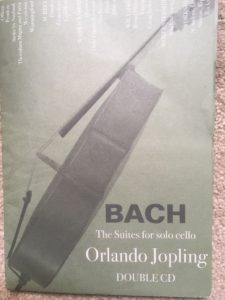
Orlando Jopling. Bach Cello Suites. Publication in 2011 via http://www.cellopilgrimage.co.uk/
St Andrew’s Church Fingrinhoe, Essex Sept 2010 is the recording venue. Jopling plays the “Bombay” Benjamin Banks Cello made in Salisbury in 1785.
The Project.
Orlando Jopling has introduced this recording as the core element of his “Cello Pilgrimage project”. The project dates from 2011 and it is ongoing. Albeit with more recent concerts by the cellist Rowena Calvert. Essentially the project celebrates the many smaller Churches in the UK. The project raises funds for restoration. All the proceeds from sales of the CD and entry to concerts go to the Churches.
At concerts Jopling plays the Bach Suites as well as other music for solo cello. (Yes other solo cello music does exist!). Full details are found on an excellent web site via the link above.
Copies of the CD can be obtained from that web site. Alternatively it is available on You Tube and Spotify to stream.
The Cellist.
Orlando Jopling appears to be a very hardworking and talented musician. Firstly, his web site is refreshingly free of hyperbole and is a lesson for others in understatement. Secondly, not only is Jopling a skilled cellist, but a conductor of opera and artistic director. He must have great skills in collaboration. For instance, setting up a contemporary opera company as well as the Cello Pilgrimage project.
I always feel the test of good project management, is how long it sustains. That, I feel, is demonstrated here after 10 years and the involvement of another cellist. More details of the performer’s resume are found here: https://orlandojopling.blogspot.com/
The Recording.
Jopling makes reference to using the natural acoustics of smaller Churches. He, the producer Jonathan Lyness and engineer Richard Hughes have done an excellent job. Moreover, in capturing a very natural sound without undue echo, they retain good tonal quality across the range of the cello.
In the web site description, Jopling indicates that he likes to practice at each venue for a couple of hours to assess the acoustic. The importance of this in Churches needs emphasis. Even in my amateur status I never cease to wonder how varied Church acoustics can be and how challenging in terms of positioning and getting aural feedback.
The Music.
I am aware right from the start that Jopling loves this music. He plays with a lovely light and relaxed tone which is still full and powerful where necessary. There is no stress in the tone which ensures a comfortable listen.
There is plenty of variety in the cello character, with almost whimsical feel to lighter movements. On the other hand there is rhythm and power in Gavottes and Gigues (special mention for the fourth Gigue). Whichever movement he plays, Jopling caresses and shapes the notes. The style he uses generally is more romantic with a lot of give and take in tempo. He articulates faster movements such as Courantes very well.
The Fifth Sarabande intrigues. It retains a starkness and certain dryness from minimal vibrato but, rather than the usual legato smooth flow that many use, the performer separates the notes with just enough space between to visualise dancers stepping backwards and forwards.
Some might find the pace of the third and sixth preludes to be on the slow side but the artist uses the additional time and space well to imbue more musicality I feel.
Summary.
In conclusion, I strongly recommend this recording. Primarily for its musicality and ability to communicate the emotion of the Suites.
However, there is the added association of money raised for Church projects. Further, it is important not to under value the social enrichment of Church organised concerts. Members may themselves perhaps entice those who rarely attend classical events. I urge any reader to get in touch with the artist and buy a copy, it will reward you well!
Charles.